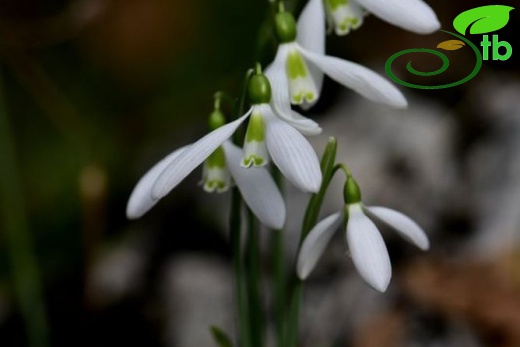Galanthus bursanus
Galanthus bursanus
Bulb narrowly ovoid to ovoid, 2.2 – 3.5 × 1.4 – 2 cm, bulb scales whitish, bulb fully covered with a light brown to straw brown papery tunic; adventitious roots whitish. Basal sheath ± tubular, tubular-conical, circular or oval in cross section, 3.1 – 6 × 0.3 – 0.7 cm, noticeably veined, slightly inflated, whitish to greenish . Leaves hysteranthous, applanate in vernation, at flowering time either absent or 1.8 – 3.1 cm long, developing in length and width after flowering; leaf blades narrowly linear to linear , indistinctly canaliculate at early stage, slightly twisted, at maturity 21 – 32 × 0.6 – 0.9 cm, bearing 2 noticeable longitudinal folds, each 1 – 2 mm from the margin , the folds diminishing terminally and then the margin subrevolute to flat; abaxial surface with a prominent keel, dark green base-colour, with glaucous covering on both surfaces , matt, with greener margins adaxially ; apex obtuse, flat, with a small white point at tip. Scape 2, rarely 1 or 3, 10 – 18 cm long, 1.7 – 3 mm in diam., light green, dark green in upper part, glaucous. Pedicel 1.2 – 4.2 cm long, 1 – 2 mm in diam., light green. Spathe papery, slightly arcuate, with 2 thick ribs on margins, 22 – 45 × 4 – 7 mm, ± equal in length to the pedicel at flowering, dark green, glaucous. Flowers narrowly ovoid to pyriform when closed , strongly fragrant; perianth segments 6, separated, in two whorls; outer perianth segments 3, narrowly obovate to obovate, indistinctly ribbed, 26 – 34 × 9 – 13 mm, white, base unguiculate, claw 3 – 7 × 2 – 4 mm; apex acute, slightly cucullate; inner perianth segments 3, ± ½ the size of the outer perianth segments, broadly to narrowly obovoid to obtriangular, white, each segment with an apical sinus and two green marks, one apical and one basal, or one entire abaxial bold X-shaped mark; on the abaxial surface, the apical mark Λ-shaped, often narrower above the sinus, mostly looking like two fused commas; the margins near sinus curled upwards ; the basal mark mostly trapezoidal and indistinctly notched in upper and lower areas, rarely obovoid or like two fused narrowly obovoid or oblong strips, bold near the base, or separated from the receptacle by a 2 – 3 mm white gap and covering up to slightly more than half of the segment, 9 – 15 × 5 – 9 mm; adaxial surface with 3 – 4 coaxial green lines, forming blurred apical and basal marks, and interspaced with a central white groove and 3 – 4 white coaxial grooves at the margins; stamens 6, in two whorls; anthers basifixed, ± sagittate, orange, connective c. 2.5 × 0.6 mm, anther sacs 4 per anther, c. 6 mm long and c. 1.2 mm in diam., latrorse in the middle part and introrse to the apex; anther apex sharply acute with multiple villi; filaments c. 2 mm long, white; pollen orange, microsporangia ± oval, with lipid drops in exine, c. 35 × 25 μm. Gynoecium syncarpous, tricarpellate; ovary superior, globose, or ellipsoid to narrowly ellipsoid, indistinctly triangular in cross section, bright green, 4 – 12 mm long, 3 – 8 mm in diam.; placentation axile, ovules 12 – 18 per locule; pistil filiform, style 7 – 10 mm long and 0.3 mm in diam., greenish, with numerous villi in the upper ½ ; stigma capitate, trilobed, c. 0.3 mm in diam. Fruit at maturity indistinctly triangular in cross section, globose to ellipsoid, or narrowly ellipsoid, at maturity 0.9 – 1.7 × 0.6 – 1.5 cm, bright to light green; seeds ± orbicular to ovoid, 3 – 4.5 × 2 – 3 mm, with shiny light to dark brown reticulate seed coat and ± developed whitish elaiosome , 1 – 3.5 mm long.















